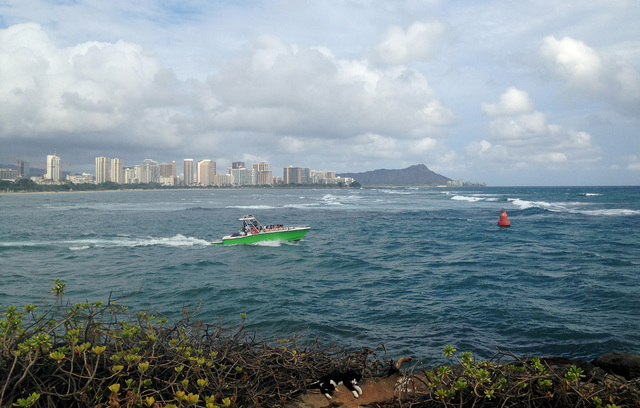HONOLULU — Waikiki’s white sand beaches mostly were deserted after officials warned the public about a half-million-gallon sewage spill in Ala Moana Beach Park, which is adjacent to the world-famous tourist destination. ADVERTISING HONOLULU — Waikiki’s white sand beaches mostly
HONOLULU — Waikiki’s white sand beaches mostly were deserted after officials warned the public about a half-million-gallon sewage spill in Ala Moana Beach Park, which is adjacent to the world-famous tourist destination.
Heavy rain associated with Tropical Storm Kilo caused manhole covers in Honolulu to overflow with sewage and the Honolulu Zoo to flood Monday, prompting officials to close an area of beach, including Waikiki.
The Department of Health is testing a 4-mile stretch of waterfront from Kapahulu Avenue in Waikiki to Point Panic in Kakaako. Sewage came out of manholes at Ala Moana Beach Park, on a street fronting a shopping mall at the edge of Waikiki where there’s two pumping stations.
Keith Kawaoka, state Department of Health deputy director for environmental health, said at a news conference Tuesday: “It depends where the tidal flow is. It depends on the high tide, low tide situation, where the currents are flowing. That’s why we’re doing sampling in over 20 areas from Kakaako to Diamond Head to determine where the extent the sewage might have flowed to.”
Still, dozens of visitors waded into the water, and young parents carried their toddlers into the ocean, ignoring the warning signs about unsafe water.
Carmen Antaky went swimming Tuesday in Waikiki with her friend, Sloan Hill-Lindsay.
“I guess a lot of people are freaked out about it. We still jumped in,” Antaky said.
They said they go in the water every day and were willing to take their chances.
“We’re also from LA, where it’s pretty polluted anyways,” Hill-Lindsay added.
Officials said Tuesday the Waikiki Beach area was not closed because of the nearby sewage spill. Rather, they said the area was closed out of an “abundance of caution,” and because water from the flooded zoo flowed directly into storm drains, which is not treated before entering ocean waters.
“Would you rather swim with human feces or possibly with animal feces,” said Shayne Enright, a spokeswoman for the city’s Department of Emergency Services.
There was a statewide brown water advisory issued, recommending people stay out of all ocean waters, but the only beaches to be fully closed with posted signs and lifeguard warnings were from just west of the sewage spill site east to the end of Waikiki beach, where the zoo is located.
There are two pumping stations in the area where the spill occurred, but a key part serving one of them was missing because of construction when the storm hit, said Lori Kahikina, Honolulu’s director of environmental services, on Tuesday.
Kahikina expressed regret that various city departments hadn’t better communicated to ensure both pumping stations were operational.
Officials said Monday that debris was clogging storm drains and there were reports of people opening manhole covers to let the storm water drain into the sewage system, even though sewage pipes and pumps aren’t designed to handle that volume of liquid.
Waikiki was not the only area of Oahu that was affected by an overflow of wastewater. The state Department of Environmental Services said Kailua, Kaneohe and Kalanianaole Highway in Aina Hina also experienced overflowing sewer systems. The Department of Health issued warnings for people to stay out of the water in all affected areas, including Kaneohe and Mamala bays, though no signs were posted.







